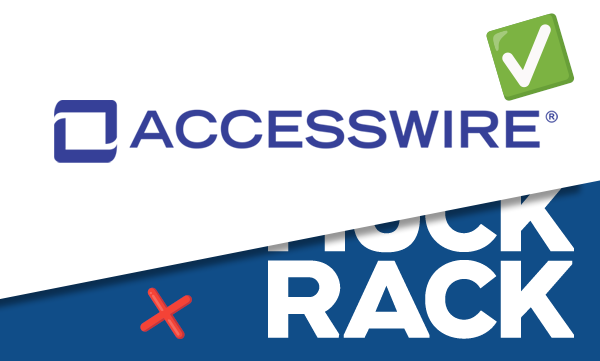How to Look at Press Release Analytics
When you think of data analytics, our minds might automatically jump to overly complicated graphs with lines going in every direction.
Luckily, analytics isn’t nearly as complex as it seems, and that’s because “analytics” is just a fancy term for the group of metrics that measures performance.
Data analytics are especially important for press release distribution.
Companies want to know a few things:
- Are people reading their press releases?
- Is the method of delivery effective?
- Do they need to make any changes to maximize the effectiveness of their press release distribution efforts?
Press release analytics can answer all of these questions and more.
In this blog, we demystify press release analytics by focusing on the metrics you should pay attention to and how you can use them to drive brand engagement.
How to Look at Press Release Analytics: 3 Key Metrics to Consider
Several factors play a role in determining the success of press release including the type of press release and the objectives.
To see results, you’ll want to use the inverted pyramid to ensure you have the proper press release format and look at analytics to optimize future campaigns.
That said, there are a few go-to metrics you should use to measure campaign performance including:
- Coverage and visibility
- Website traffic
- Backlinks and placements
Let’s break these three metrics down further and start with the most important: coverage and visibility.
1. Coverage and Visibility
“Coverage and visibility” refer to the publicity your press release received.
Typical questions answered by coverage and visibility data analytics include:
- How many news sources picked up my press release?
- Did any influencers share my press release?
- Was my press release mainly distributed via print, digital mediums, or both?
- Did engagement increase via multimedia?
When considering these questions, it’s important to remember that though similar, visibility and actual reads shouldn’t be treated the same.
While visibility measures how visible your message is, readership tracks how many people read your news. Readership is more important.
That said, track all aspects of coverage and visibility by focusing on the following:
Headline Impressions
Ask yourself: “how long should a press release be?” and “Is my headline compelling?” If you’ve ever written a press release or news article, you know the value of a good headline. Audiences are less likely to click on your news without an attention-grabbing
press release headline.
Headlines are also effective tools for tracking your press release’s coverage and visibility and gaining actionable insight.
This is because headline impressions illustrate:
- Location – Tracking headline impressions gives you valuable information about where your press release has been viewed. This, in turn, lets you know which publications and geographical regions are the most effective conduits for your press releases. For instance, if headline impression data reveals that Midwestern publications are responsible for most of your press release views, your company might focus more on this regional audience.
- Keyword effectiveness – Not all keywords are created equal. If certain headline keywords are more effective than others at generating clicks, headline impression data will reveal this. Gauging keyword effectiveness is a crucial step when it comes to writing engaging headlines.
Measuring headline impressions is a strategic way to track your press release’s coverage and visibility.
However, coverage and visibility data aren’t complete without considering social media engagement.
Social Media Engagement
Companies must monitor social media for brand engagement in today’s digitized world.
This is especially true when analyzing the effectiveness of press releases because social media is, for many people, the first place they engage with the news.
To monitor social media engagement as a part of your coverage and visibility analytics, note the following:
- Platform – Is your press release mainly visible on Twitter or Facebook? Instagram or LinkedIn? Knowing the platform where your news is most visible (or, even better, trending) will help when deciding the best social media platform to use to share your news.
- Influencers – Few people are as powerful as social media influencers in raising awareness for a news story. Influencers can amplify readership by promoting your press release through their content and profiles. You can also reach out to a specific influencer with a history of promoting your press release whenever you have news to share.
Now that you know how to measure coverage and visibility metrics, let’s look at another essential metric: traffic.
2. Website Traffic
In the world of press releases, traffic’s a good thing.
That’s because traffic measures how many people view your content and website from other sources.
One of the most common ways to measure traffic is by analyzing how many people visited another website, clicked on your press release’s link, and were directed to your website.
Traffic analytics typically seek to answer the following questions:
- Which outside websites brought the most visitors to my website?
- Are some search engines better than others at driving traffic?
- Once referral traffic reaches my website, is my site effective at conversion?
Using traffic as a metric to measure the effectiveness of press releases comes with many benefits.
Not only do you get hard data on the number of people who visited your website based solely on your press release hyperlink, but you also know which types of referral traffic to preface.
Let’s dive deeper into these different types of referral traffic.
Referral Traffic
Referral traffic’s the inbound traffic type concerned with how many people accessed your website via another source.
To most accurately gauge the effectiveness of your press release, monitor referral traffic from the following sources:
- Highly-trafficked websites – Highly-trafficked websites are websites that receive lots of visitors. These websites include major news publications and entertainment sources. Distributing your press release to one of these websites can create an influx of attention. It's important to know whether one major source is driving most of your traffic. Knowing this information empowers you to distribute press releases to that outlet first.
- Social media – As stated above, social media’s a powerful tool. Monitor social media referral traffic in order to know where to direct your attention. For instance, if your photography company routinely distributes new product press releases, you might want to track traffic from a photo-based platform like Instagram.
- Blogs and forums – From blogs centered on fantasy football to forums diving into fall fashion, the list of blogs and forums is nearly endless. As a result, distributing your press release content to popular blogs is beneficial—especially if your company markets a product to a niche market. Knowing which blogs and forums deliver the most inbound traffic will give you a leg up when deciding where to distribute your campaign.
Keeping an eye on inbound traffic is an effective way to sharpen your press release analytics. But to monitor referrals, you must effectively distribute your campaigns in the first place.
Cue: ACCESSWIRE.
As a newswire service standout that provides regional, national, and global news to thousands of clients worldwide, ACCESSWIRE makes it possible to connect your press releases with the most relevant sources.
That means more eyes on your news—and more clicks on your website.
3. Backlinks and Placements
If coverage and visibility metrics are concerned with how many sources pick up your press release, backlinks and placements metrics gauge the reputation of those sources.
Reputation follows reputation meaning, if high-quality sources consistently include hyperlinks to your press releases, your website is deemed valuable and ranked higher for SEO purposes.
Let’s break down these crucial metrics further.
Backlinks
Like inbound traffic metrics, backlink metrics measure the number of links that direct back to your website.
In general, the more reputable the source, the more valuable the earned backlink.
This, in turn, allows you to monitor the effectiveness of the press release that led to the backlink.
For example, suppose your investment company distributes a new partnership press release that’s read by a major financial publication.
The publication then uses your press release as the basis for a news article and includes a link in their write-up directing readers to your website.
Not only have you earned a backlink, but you’ve also earned a standing in the financial industry based on the reputation of the financial publication.
Placements
Placements are another press release metric worth tracking.
In short, placements analytics monitor where your press release was distributed in more detail.
Placements metrics focus on two main categories:
- Place of publication – Although visibility matters when it comes to press releases, where your press release is visible matters even more. For instance, if your video game company distributes a general news press release, it’s better to have your press release picked up by a leading publication in the video game industry. This lets you know that your press releases are reaching their intended audiences. If not, you may need to retool your press release strategy.
- Journalist or blogger – Besides letting you know which publications picked up your press release, placements metrics can also let you know the specific journalist(s) and blogger(s) who used your press release in their content. Knowing this information allows you to build a rapport with this source, which enables you to send them information as soon as news is released.
Backlinks and placements metrics are valuable tools for understanding how best to reach your target audience.
Connect Farther with ACCESSWIRE
With names like inbound traffic and backlinks, press release analytics can sound like mystical, mysterious language.
Fortunately, we’re here to translate.
In addition to flat-fee pricing and wide press release distribution, ACCESSWIRE uses the industry’s best analytics to help your message reach the widest audience.
Explore our press release distribution offerings and feel confident knowing your press releases are headed in the right direction.
Similar Blog Posts



PRODUCTS
ACCESSWIRE | All Rights Reserved


